Peru is a nation with a rich history and a very vibrant present full of Peru cultural events. Click through the months below and read about the festivals in Peru you can witness throughout the year. Apus Peru can assist you to visit any one of these special cultural events. Use our cultural events calendar to plan your trip to Peru with precision!
This list is by no means exhaustive and doesn’t include some important Saint’s Days and corpuses. Some cultural events in Peru do not have a fixed date, but rather fall on different dates each year, like Easter. For more detailed information about any of these cultural events, please email us!
You can also check out these informative articles:
Please note that these are local Cusco festivals and Peru cultural events. We have described the event to the best of our knowledge, based on past experience. We cannot guarantee that the event will occur on the date we have listed, or in the way we have described. These are genuine cultural festivities which unfold according to the local rhythm. They are not staged events and attending one requires an open mind, and often a good deal of patience.
An interesting Peru cultural event, El Sinkuy is a ceremonial ball game that is played in Ollantaytambo on the afternoon of January 1st. It is organized by incoming officials (varayocs) from the surrounding communities of Huilloc, Patacancha, Kellkanka and Yanamayo. The purpose of El Sinkuy is to introduce new varayocs and other community leaders to the people of Ollantaytambo.
Early in the afternoon, community members in festival dress begin to gather in Ollantaytambo plaza, bringing with them jugs of chicha and breads in the shape of different animals (ch’askhuacos). The game itself is played with six poles decorated with red flowers, which pairs of players attempt to knock down with two wooden balls. The mayor of Ollantaytambo and the wife of a community leader are the first pair to play. Each man that participates contributes a small amount of money each time they play, which varayocs use to buy food and drink for community members once they return home. Throughout the game, the bellow of pututus, or shell trumpets, can be heard, lending a distinct atmosphere to the event.
The Bajada de los Reyes is one of the most important and interesting Peru festivals throughout the Sacred Valley, but is celebrated most colorfully in Ollantaytambo. This Cusco festival celebrates the biblical Visit of the Three Wise Men and coincides with the taking of power of the varayoc (community leader), whose authority is given to his successor with a silver-tipped staff as a symbol. The staff is made of native wood species such as tucuma, black hualtaco (tagetes minuta), huallacán or quince, and measure approximately one meter in length.
Residents of surrounding communities walk to Ollantaytambo in festival attire, with the communities of Huilloq and Patacancha carrying the image of Melchor (known as Marcacocha) and accompanied by varayocs and dancers. The beginning of the festival is marked by their arrival in the Ollantaytambo plaza. The festival features a procession in which two images, The Christ Child and San Isidro the farmer, are walked around the city, and offers the opportunity to observe the traditional dances of Huayllascha, Huallata, Herreros, Sinkuy Wata Callarity, Chucchu and Negritos. A bullfight takes place in the afternoon of January 6th.
>> Want to go? Ask us about our Christmas in Peru Packages!
Among Peru cultural events, the Chiaraje is one of the most dramatic. The Chiaraje takes place in the remote province of Canas, about a 4 hour drive from the city of Cusco. This is a Cusco festival of ritual battles or pucllay (war games) that are supposed to give life to Pachamama (Mother Earth) and for the people to receive her favors during the harvest. This affectionate battle is related to the fertility of the earth, which is why it takes place at the end of January, during rainy season. The aim of the ancient battle is to give service to the exhausted earth and the winner of the battle can expect a rich life. In the past, a death at Chiaraje was an offering to Pachamama. Therefore, the families of the warriors that died during this battle didn’t cry for their lost family members.
This festival is held every 20th of January. Participants from two communities engage in battle using a variety of weapons. The winner is the group to capture the largest area of land. At dawn, you can hear angry shouts and songs about war. The men ride on horseback, encouraging the rest of the people to run together to the base of Chiaraje hill. Here, a ritual battle takes place that comes from the time of Túpac Amaru II (Jose Gabriel Condor Canqui). He rebelled against the abuses of the Spaniards and is still regarded as a hero. Here in the highest part of the Andes we can still find extremely traditional zones with cattle farmers and textile artisans. Also, the Canas province is considered to be an area of very proud warriors.
Hundreds of women come to the hill Chiaraje. They wear typical clothes that are decorated with fresh flowers. They stay far away from the place where the ritual battle takes place and they prepare food and liquor to sell afterwards. The warriors wear embroidered clothes and bring catapults and whips with them. They use these weapons during the attack. In the beginning of the assault they will go down the hill while they are threatening and challenging the enemy, insulting them to destroy their honor, their manliness and pride. Together these warriors move to the front of the field to finally take the hill of the enemy and therefore become the winners.
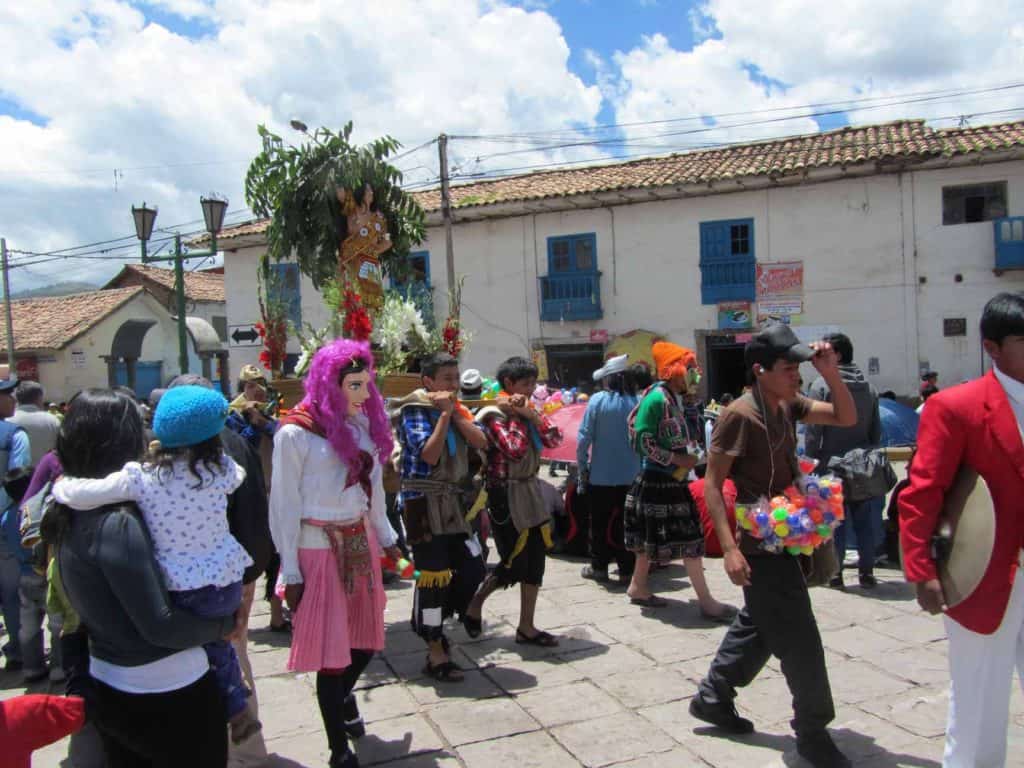
The festival of San Sebastian is located in Plaza San Sebastian in the city of Cusco and features traditional dancing, food and music.
The Virgen de Copacabana (Blessed Virgin of the Candelaria, Our Lady of Copacabana) is the patron saint of Bolivia, but this is also an important festival in Peru. She is venerated in Bolivia during her feast day of February 2, the day of the Purification of Mary, or feast of the Virgin of Candelaria. She is also venerated on August 5 with her own liturgy and popular celebration.
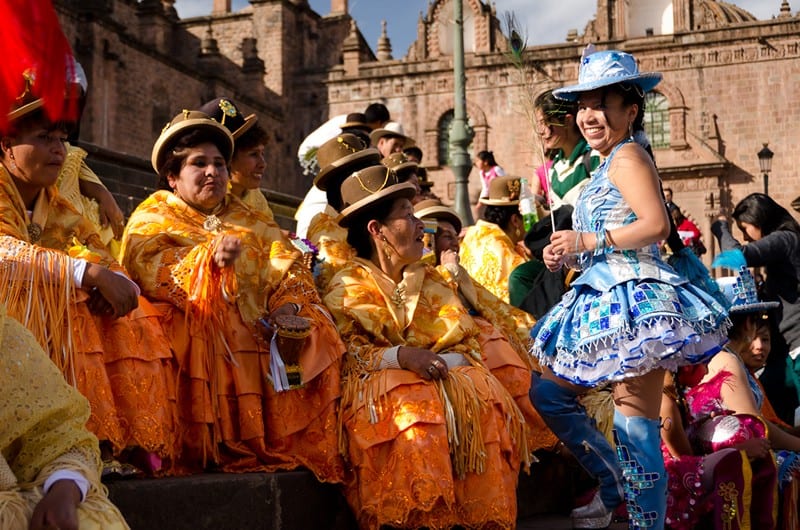
Located in the city of Puno, this colorful celebration of dancers is one of the most famous of the Peru cultural events. This is one of the most important religious celebrations to honor the Virgin of the Candelaria (also known as Virgen de Chapi or the Virgen de Copacabana). Approximately 50 musical groups from all over Puno perform wearing very attractive costumes. It is a beautiful combination of colors, beauty and high spirit.
Puno (3870 m / 12,770 ft) is famous as the jumping off point for excursions to Lake Titicaca, the highest navigable lake in the world. Puno is also famous as hosting one of the biggest Catholic feasts in Peru, the “Candelaria.” During 16 days, from the 2nd to the 18th of February, Catholic devotion and the carnival spirit mix in the streets, with thousands of dancers and musicians moving around the city in an endless parade.
The feast starts before dawn on February 2nd, when the authorities go to the top of a hill to pay homage to the Virgin Mary, patron of Puno. Then, with the first rays of light, they descend to the city among firecrackers, bands and dancers, toward the San Juan Bautista Church. This church is the sanctuary of the image of the Virgen de la Candelaria. After the mass, the first procession of the image takes place. In the afternoon, people from the countryside enter the city on horses accompanied by the yachiris (or yatiris, shamans and witch-doctors) who also present their honors to the image.
On the first Sunday of February, a big competition takes place in the city’s stadium. Up to 70 groups of dancers from different towns and communities come to Puno to compete in an incredible contest of local cultural dances, making this one of the largest of the Peru cultural events. The average group size is 100 people (with dancers and musicians) and they perform choreographed dances wearing festival costumes. They compete in honor of the Virgen de la Candelaria and for the pride of their town or community. After the contest, the groups of dancers continue dancing in the streets, which turns the city into a huge party for the next 7 days.
Nevertheless, the real party starts on the 8th day of the feast, and during the next 8 days hundreds of people take to the streets. Huge parades with as many as 300 people, all dressed up in outfits of devils and demons, will fill the city with music and magic. There is another competition between the neighborhoods of the city who organize these parades and perform in the last 8 days of the feast. The prize goes to the parade with the best outfits and performance. The outfits include heavy masks and dresses with mirrors and jewels. Most of it has been prepared especially for the feast.
The celebrations end on the 18th, but only until the next year. Then, the people of Puno will again go to the streets to dance in honour of their patron in this interesting Peru festival, Virgen de la Candelaria.
You may not think of Carnaval as being one of the big Peru cultural events; Carnaval is most famous in Rio de Janeiro, Brazil. But it is also quite a popular cultural event in Cusco and the Sacred Valley. All through the month of February, the pucllay or game can be seen in the city. The Carnival begins with the “Day of Compadres” in which people display their joy with flowers, paint, and water. As locals get into the spirit of things… expect to get wet!
The ritual of “yunsada” is widespread. A specially-transplanted tree is bedecked with gifts, and guests dance around it before it is ceremoniously felled. The couple who strike the final blow of the axe to bring down the tree are given the honor of organizing next year’s celebrations, which will likely include paying for much of the party. This is a huge honor for many families, as well as a significant economic burden. The yunsada or yunza is more frequently seen in rural areas than in the City of Cusco.
In Cusco itself, you are more likely to see dances and kids playing with water or foam on the octavo – the eighth day after Carnival begins.
During the month of February, communities located within the Patacancha Valley gather for the Compadres fiesta in Maracocha. This event is an excellent opportunity to interact with locals and observe the distinct cultural customs of each community.
Grape harvesting, dancing, Pisco and wine tasting! The Fiesta de Vendimia is one of the must-attend Peru cultural events for those who love their wine and Pisco!
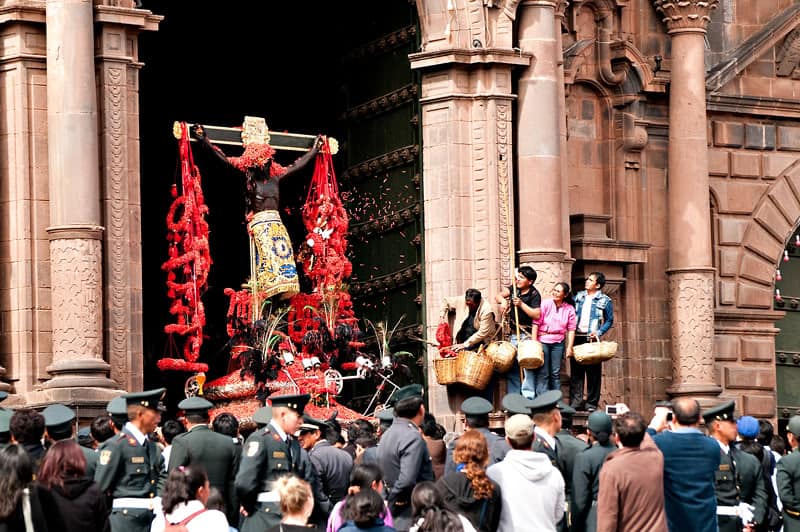
Ever since 1650, when the faithful claim that an oil painting of Christ on the Cross held off a devastating earthquake that was rattling the city of Cusco, the locals have been rendering homage to the image of Taytacha Temblores, the Lord of the Earthquakes.
The Lord of the Earthquakes is held on Lunes Santo, the Monday before Easter weekend, against the backdrop of Easter Week in the city of Cusco. This celebration is of particular interest because it allows on-lookers to get a glimpse of the fusion of Andean religion and Christianity.
Tradition says that this depiction of Christ carried around the Plaza de Armas of Cusco during an Earthquake saved the city. The Plaza is packed full of people every year on this special day. This is worth seeing if you are around!
The Cusco Cathedral, where the image is kept, is built on the foundations of the ancient temple dedicated to the pagan god Apulla Tikse Wiracocha. The image of the Lord of the Earthquakes is borne aloft in a procession through the streets of the city just as the Incas used to parade the mummies of their chieftains, high priests and supreme rulers. In the end, the dominating part of the celebration involves the ñucchu flower (salvia esplendes), used as an offering to the ancient gods Kon and Wiracocha.
The same flower today is used to weave a crown for the Lord of the Earthquakes. This crimson colored flower, whose petals are scattered by the faithful over the venerated image, symbolizes the blood of Christ. The image used today was donated by King Charles V, and despite centuries of smoke from the candles and incense, no one has dared to restore the blackened painting which has given the Christ a somber aspect and a dark countenance.
Within Cusco culture, each family believes in a different version of the Lord (Lord of Qoylloriti, Lord of the Miracles) however, everyone seems to turn out to pay homage to the Lord of the Earthquakes, as serious seismic activity is a real threat to the beautiful city of Cusco.

Easter is an important cultural event in Peru, and the Easter Week celebrations are most famous in the provincial city of Ayacucho, about 12-14 hours’ travel by bus from Cusco.
In Cusco, Holy Week is one of the examples of Spanish heritage. On Monday, the biggest religious procession takes place in Cusco. The Señor de los Temblores is walked around the main streets of Cusco followed by thousands of people. During the rest of the week, Death and Resurrection are remembered through processions, the preparation of the Twelve Dishes, and fasting. Compared to other Cusco festivals, the Easter celebrations are not as colorful and won’t be very obvious to the casual visitor.
Holy Week is incredibly beautiful in Ayacucho and is celebrated with great pomp and the religiosity of the people can be felt in the air. During the week there are many processions and people participate with a lot of devotion.
Read more here about the Easter celebrations in Peru!
The fiesta of the Virgen de Chapi (also “Virgin of Purification”) is a religious pilgrimage to the Sanctuary of the Virgin of Chapi, one of the most important Catholic virgins in the region, making this one of the most important Peru cultural events. The sanctuary is located approximately 45 km from Arequipa, and is filled with travelers from throughout the region and country on this day. The devout Catholics that make this 15-hour journey on foot depart Arequipa and travel throughout the night, carrying large, handcrafted candles. The next day, the virgin is carried in procession and fireworks and celebrations take place all night.

This is a religious festival in Peru brought by the Spanish and celebrated in Cusco and throughout the Andean region. Crosses are adorned with flowers and ribbons. People venerate the crosses during the night. They pray, and the crosses are carried to churches where they are blessed. Groups of musicians and dancers accompany the crosses. Read more about the Cruz Velacuy festival from a first-person perspective here!
Not one of your typical Peru cultural events, this is an annual festival celebrated in May or June and features important national and international artists and musicians. Young people from all over the country travel to Cusco to participate. This three-day festival takes place in the Beer Gardens located on Avenida de Cultura.
>> Want to go? Double check that this festival is running ahead of time, as we cannot guarantee that it will be held every year.
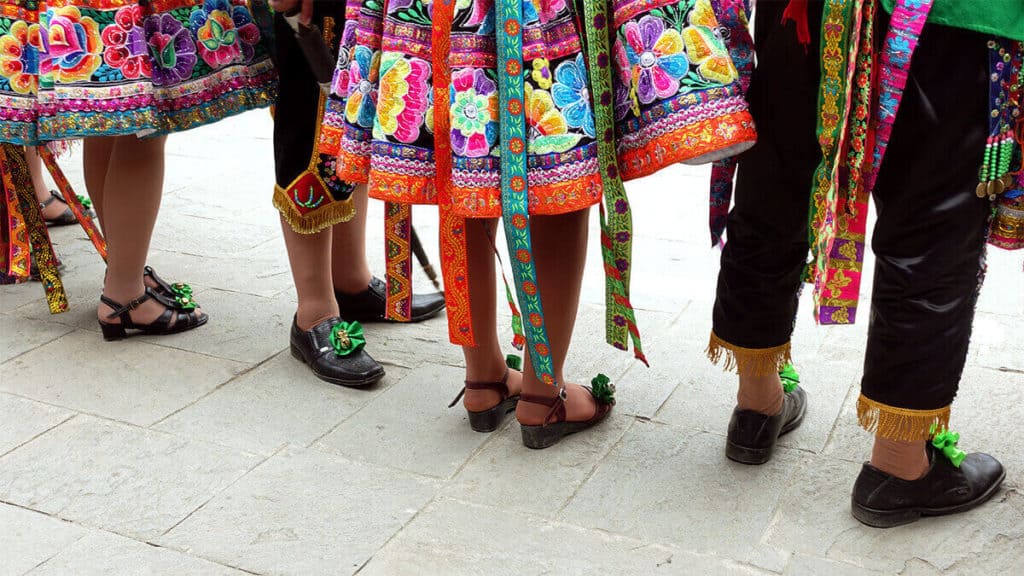
Señor de Choquekillka is the patron saint and main festival of Ollantaytambo, and includes numerous processions and celebrations. While not one of the commonly celebrated Peru cultural events nationwide, the festival is one of the most important in Ollantaytambo, and lasts for four days nonstop.
This Cusco cultural event is associated with Pentecost, and is celebrated in Urubamba, in the Sacred Valley.
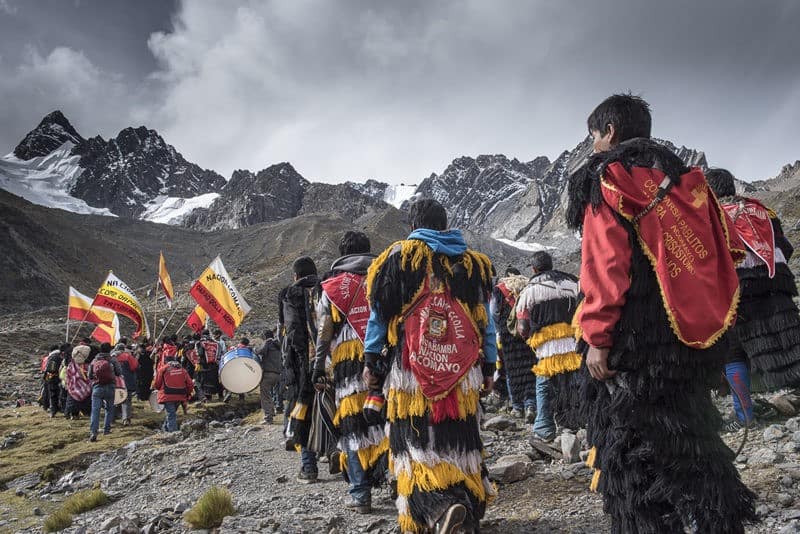
One of the most fascinating of all Peru cultural events, the Señor de Qoylloriti (also spelled Qoyllur Rit’i and Ccolloritty, among other spellings) is a pilgrimage to a remote site in the Ausangate region. Qoylloriti constitutes an important manifestation of religiosity in the Andes. The blending of Spanish and Indigenous elements is fascinating: here you will see celebration and veneration of the Apus, or Andean mountain gods, combined with crosses and Catholic religious ceremonies. Pilgrims walk for three to four hours, passing the 14 Stations of the Cross, up to the base of the Sinakara glacier, at about 4600m (15,092 ft). The crowd takes a purification bath, which is needed in order to enter a spiritual dimension where the energies of deities and people join. Get the full story in our blog, The Ultimate Guide to Attending the Qoyllur Rit’i Festival.
>>Want to go? Check out our 4D Qoylloriti Pilgrimage trek! We also offer a shorter 2D Qoylloriti Trek. Be sure to check your calendars before planning your trip! Like Corpus Christi, Qoylloriti can be held either in May or June, depending on the year.
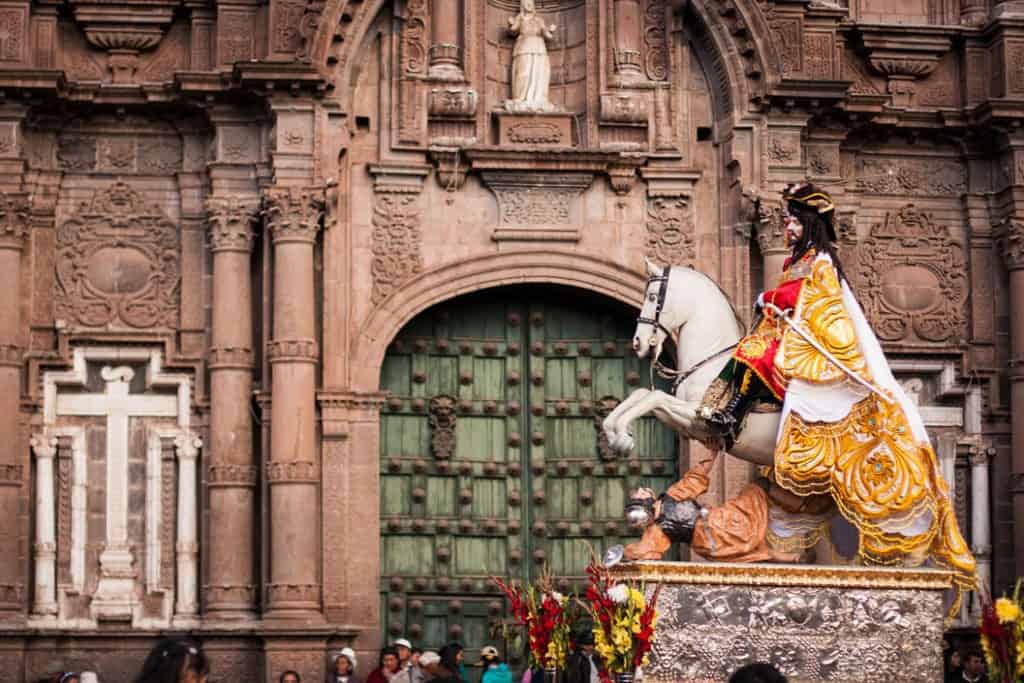
This event can be held in May or June, but always on a Thursday.
The celebration of Corpus Christi is one of the Peru cultural events celebrated in the whole country, but the festival is most impressive in Cusco. Fifteen saints and virgins, organized in several processions, arrive from different places to the cathedral of Cusco in order to greet the body of Christ, sixty days after Easter Sunday.
The night before the main day of Corpus Christi, in a tradition unique to Cusco, the doce platos are served: twelve typical dishes, including cuy chiriuchu (a guinea pig dish, served cold), beer, chicha and bread. Fruits such as chirimoya, coconut, and sugar cane are also typical.
Cusco’s Plaza de Armas is crowded with people who come to see the saints. After the procession, the saints go back to the cathedral and the representatives of the local communities come together and discuss local problems.
After seven days, on the octavo, the saints participate in the procession again before going back to their places where they will remain for the rest of the year. Therefore, if visitors have missed the actual day of Corpus Christi, they are able to see similar processions a week after the main event.
>>Want to participate? It is easy to participate in Corpus Christi in Cusco, and a spectacular event to witness as a visitor! In fact, if you are anywhere near the center of town in the days preceding the event, you are likely to encounter one of the saints making their steady progress towards the Plaza de Armas. Be sure to check your calendars! Corpus Christi can be held either in May or June, depending on the year.
Corpus Christi is also connected to the Andean celebration of Qoylloriti. You can do our 4D Qoylloriti Pilgrimage and return to Cusco in time to see the Corpus Christi celebrations the day after you return.
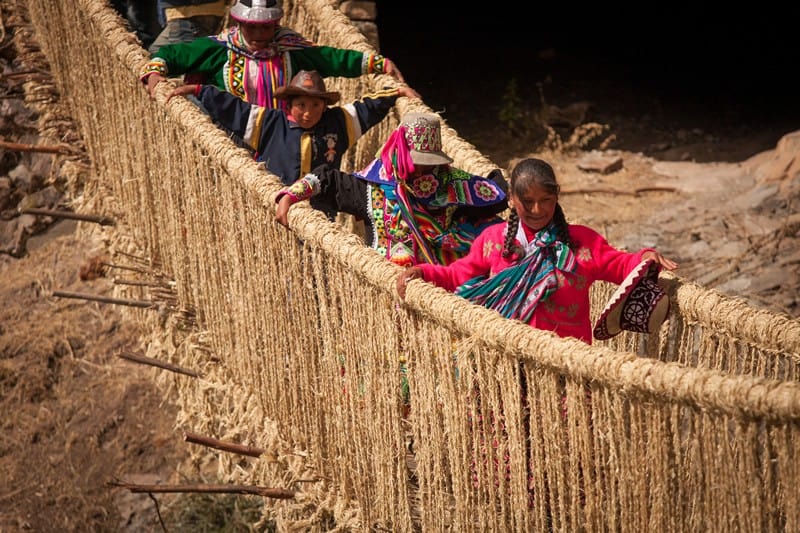
The Festival of Q’eswachaka is one of the most intriguing Peru cultural events; it celebrates the rebuilding of the Q’eswachaka bridge (also spelled Keswachaka and Queshuachaca, among other spellings).
The Incan practice of building suspension bridges out of rope is celebrated at the Festival of Q’eswachaka with the annual reconstruction of the hanging bridge crossing the Apurimac River in the province of Canas. In the three days before the principal day of the festival, the local people rebuild a narrow rope bridge, by plaiting and weaving native grasses together. On the fourth day of the festival, all the communities of Canas province join together in a folkloric festival.
Get the full details about the Q’eswachaka festival in our blog.
>>Want to participate? Join our unique tours to see the Q’eswachaka Bridge! Please note: this is not an activity designed for tourists, but rather a traditional Peru cultural event. As the bridge is being built, the process or activities may be slow or hard to follow for the average tourist. Come with an open mind, a good dose of patience, and a willingness to learn!
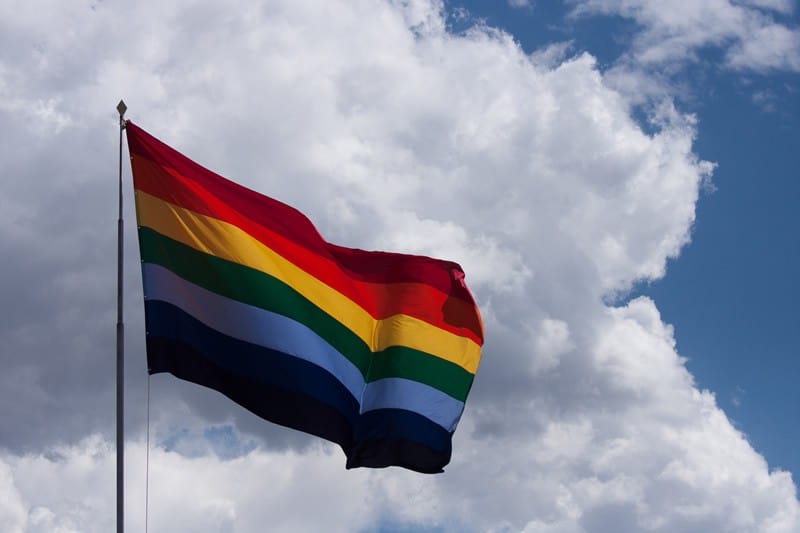
Inti Raymi is probably the most famous event in the Cusco calendar, and celebrates the Inca’s rite of the winter solstice. However, there are festivities throughout the entire month! In particular, the week preceding Inti Raymi often has more meaning for contemporary Cusqueños, with different parades every night of the week, fireworks and concerts in the Plaza de Armas. Cusqueños of all walks don their mostly-red ponchos and march, while the rainbow-colored flag of Tahuantinsuyo is hung proudly from each house. The night of June 23rd is always a massive celebration in the Plaza de Armas.
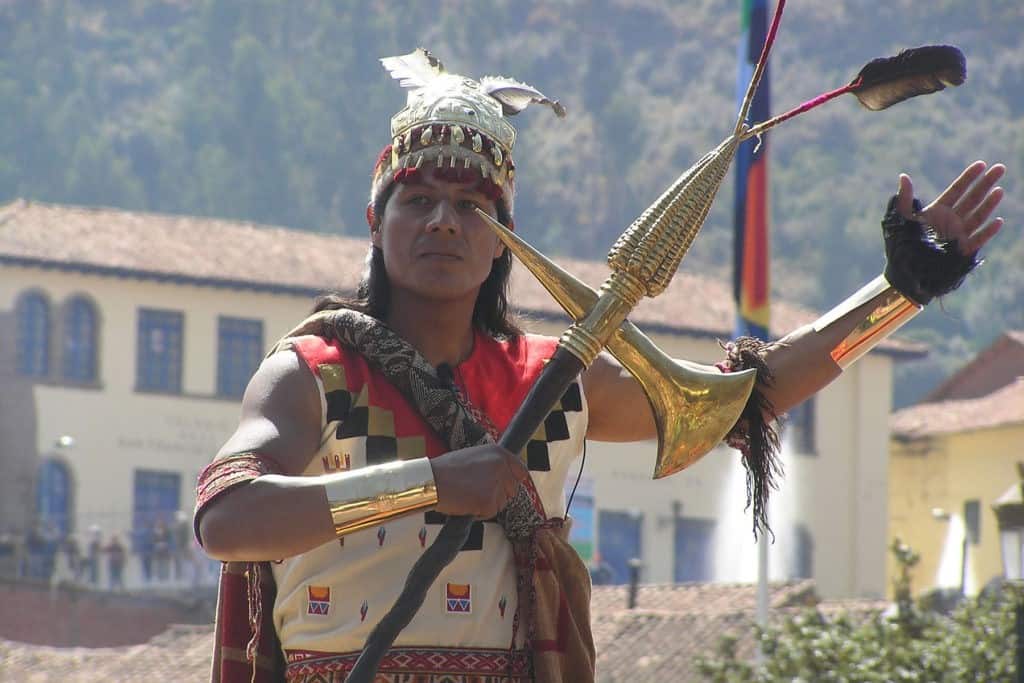
One of the biggest, most impressive and certainly most famous celebrations in Cusco, Inti Raymi is an homage to the Sun, an important god in Inca Culture. The main part of the day takes place at the Ruins of Sacsayhuaman. The Inca Empire or Tawantinsuyo based its religion on the cult of the Sun. This celebration is a symbol of the deep bond between the Sun and his children, the human beings. Read more about Inti Raymi in our blog!
>>Want to go? Join us on our Inti Raymi tour! One day only, this tour follows the procession through the streets of Cusco and includes access to the ceremonies in Sacsayhuaman. Please note: unlike most festivals in Cusco, Inti Raymi has actually been restored as a tourist festival.
Also note that Inti Raymi falls at the height of the tourist season in Peru, and all hotels and facilities will be very full. You should book well in advance to ensure you get a reservation. Also note that most top end hotels increase their prices by 15% – 30% during this week.
Another not-so-typical example of Peru cultural events, this fair is still a must for those with an interest in agriculture! Regional, national and international exhibitors present their products at this traditional fair. Musical groups from varied styles perform open-air. There is also a Festival of the 13 Provinces of Cusco whose representatives prepare typical food and play typical music.
>>Want to go? Double check that this fair is running ahead of time, as we cannot guarantee that it will be held every year.
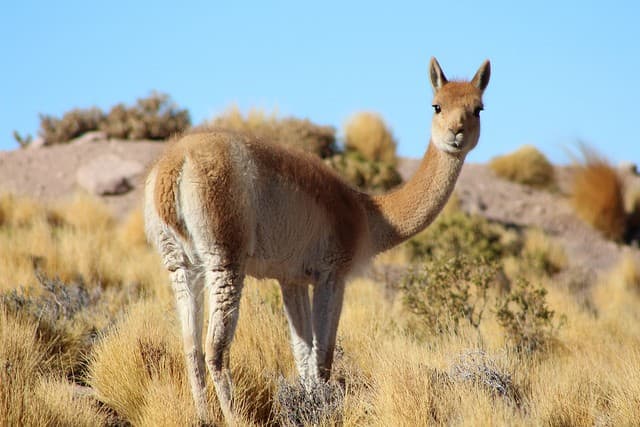
Pampa Galeras is a reserve located approximately three to four hours from Nazca. Once a year, members of local communities gather to cooperate in a roundup of wild vicuñas (called a chaccu) for shearing and release, which is followed by celebration, food, and recognition of the traditional significance of camelids (which include llamas, alpacas, vicuñas and guanacos) in the Andes.
There are events in Cusco around the Church of San Pedro, which is located adjacent to the more famous San Pedro market.
The festival of Ollantay Raymi is dedicated to the Inca sun god, and includes performances of the 18th century, Quechua-language Ollantay drama, which tells the story of the military general Ollantay and his forbidden love of a princess. This is followed by traditional dances and the opportunity to sample local dishes.
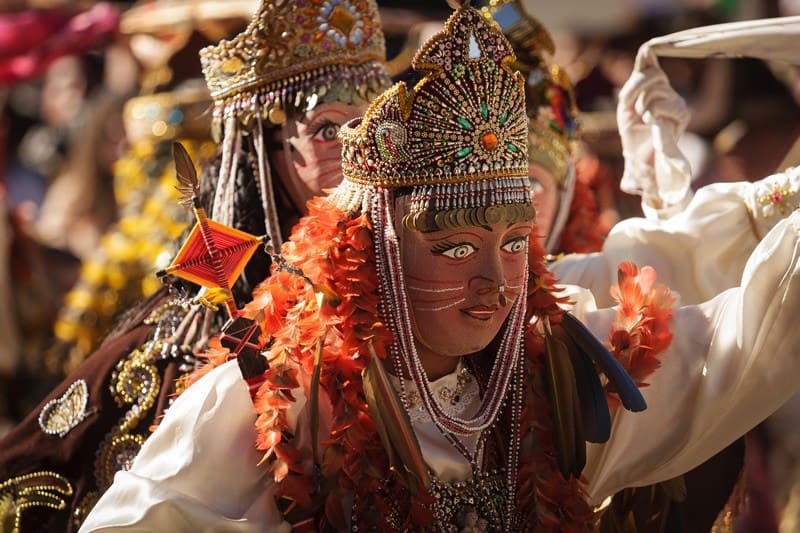
Paucartambo is a small town about 4 hours east of Cusco, on the road to Manu National Park. It is most famous for one of the most massive Peru cultural events: Virgen del Carmen. The festival takes place over four days, with the principal days from July 15th to 17th. The Virgen is known locally as Mamacha Carmen and is a patron saint of the mestizo population. This Peru festival itself consists of lots of traditional dances by people in awesome costumes. Many of these dances have ingenious choreographies that portray events in Peruvian history. Get the full story in our blog: Virgen del Carmen, A Festival Like No Other!
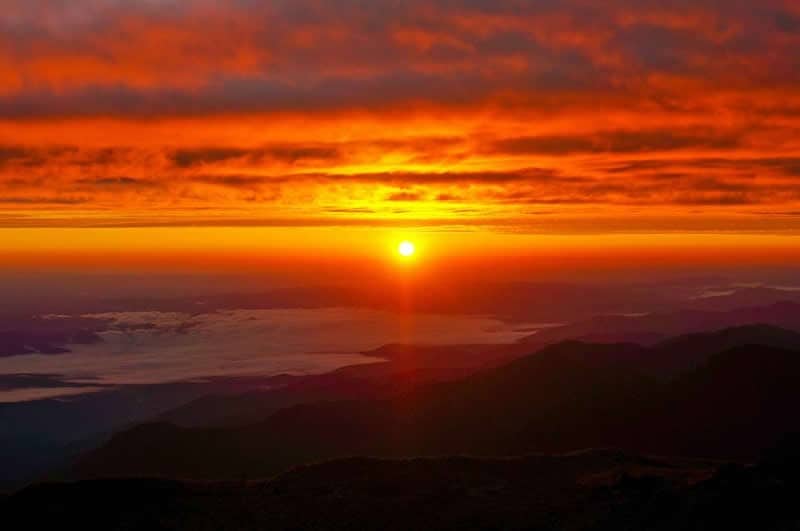
Although not strictly speaking a festival itself, visiting Tres Cruces is another of the Peru cultural events that you should witness. About 40km north of Paucartambo is a site called Tres Cruces (“three crosses”), which is situated on the very edge of the Andes mountains at an altitude of 3900m. From Tres Cruces, there is a steep drop into the Amazon basin, which means the view is incredible. Tres Cruces is most famous for the sunrise in the months of June and July because special climatic conditions produce optical illusions, and many of the Virgen del Carmen festival goers make a point of stopping here. Read more about Tres Cruces here.
>>Want to go? We offer a unique 2-day Virgen del Carmen tour which allows you to partake in the festivities and also visit Tres Cruces at sunrise! You can visit Tres Cruces any other time in June or July as well but remember: seeing the optical illusions is very lucky and auspicious, and not guaranteed!
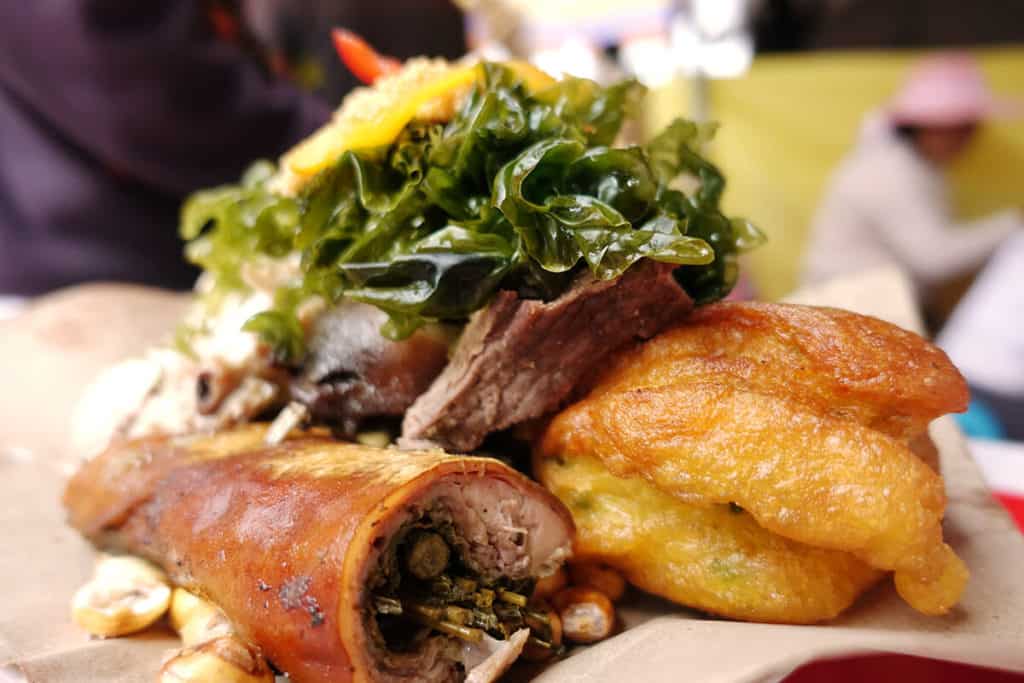
Corpus de Santiago is a religious festival in Peru that takes place in Santiago Plaza, near the center of Cusco. The festival has its own typical dish, the chiriuchu, made up of small portions of several traditional dishes. It is a cold dish – chiri means “cold” in Quechua!
The Corpus of Santa Ana is a religious celebration performed in the chapel of Santa Ana, Cusco. The day before, a festive mass is celebrated with a procession, dances and musicians. Like Corpus de Santiago, its typical dish is the chiriuchu.
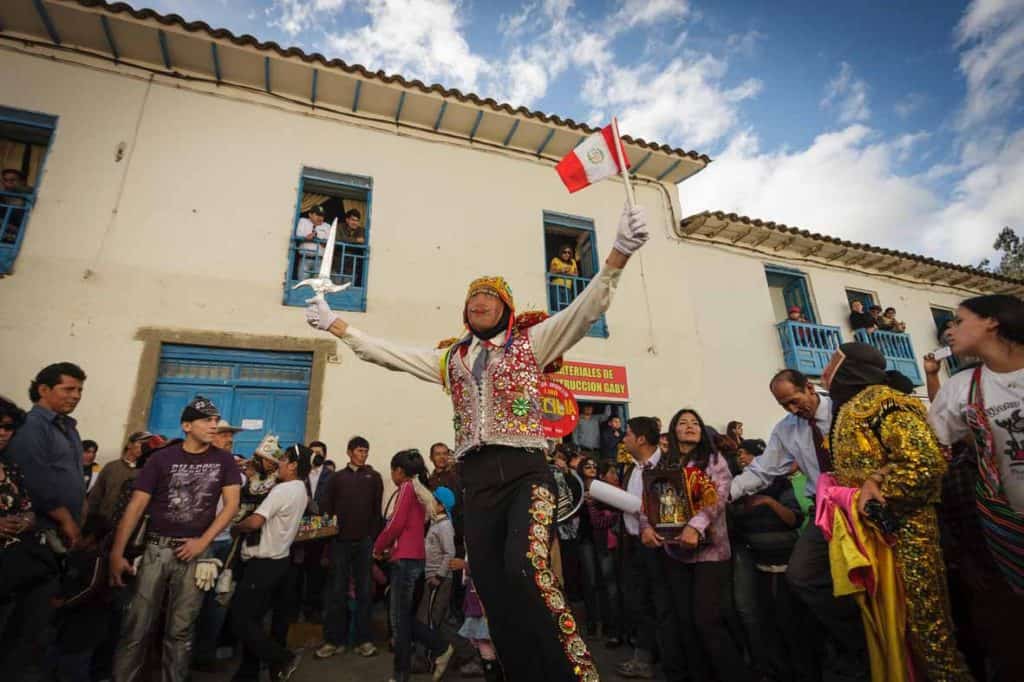
Peru’s national holiday. Like the 4th of July in the United States, most towns celebrate with lots of parades, bands and fireworks. Peruvians celebrate their independence from Spain on July 28th, and the festivities range from concerts held in the multiple squares in Cusco to streets full of processions, local food and drink, and parties in many of the bars and restaurants. Make sure to wear red and white, the colors of Peru!
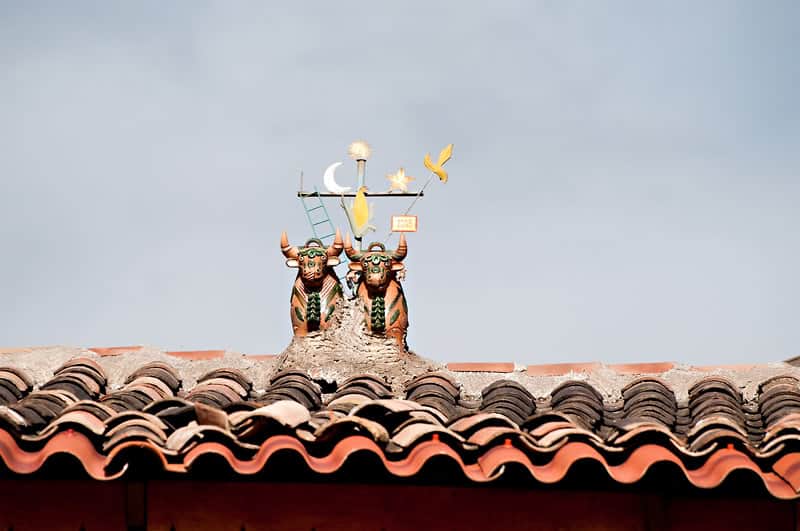
The Yawar festival is a ritual bullfight held during Fiestas Patrias in the town of Cotabambas, in the Apurimac department. This traditional ritual represents the fight between the Incas against the Spanish conquistadors, and the figure of the condor (representing the Incas) occupies a central place.
The bird is tied to the back of the bull (which represents the Spanish) who is urged on by the pecks of the bird. The young men then participate in a bullfight.
This is a cultural tradition that has been celebrated since Colonial times in many places in the central mountains of Peru. Although in the course of the 20th century it has declined, disappearing in many places, it still has an important role. It is also known as the “Fiesta de Sangre” (Festival of Blood), and is largely a ritual practiced in the traditional highland communities or ayllus.
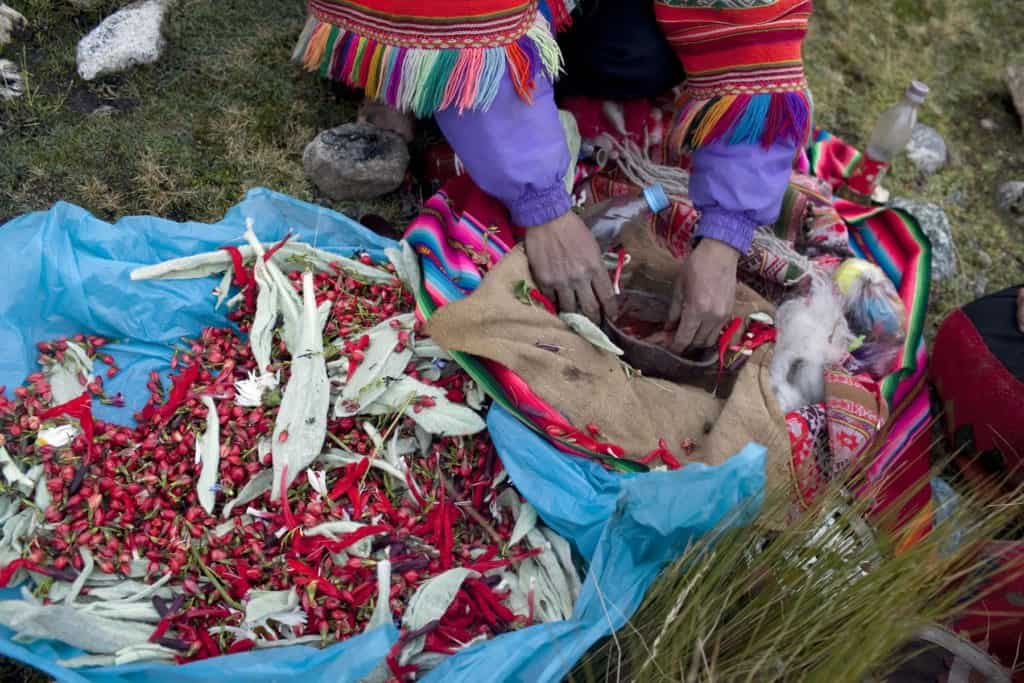
In the Andes, August 1st represents the Andean New Year, a day to honor Mother Earth. During the month of August, many Peruvian families make pagos or payments to Pachamama, Mother Earth. These pagos are done at home by the adults of the family, with the assistance a shaman, paqo or brujo. For the pago, coca leaves, sweets, incense, dried animal fetuses, cigarettes and wine are collected. During the ceremony, the paqo will drink wine, then give an offering to Pachamama. He will also smoke and often a cigarette will be left burning for the apus or mountain gods. Sometimes, after the ceremony, all the items are ceremonially burnt and then offered to the Pachamama, being buried either in the house or outside.
During August, shamans do not do San Pedro or Ayahuasca ceremonies, only pagos. Therefore, if you are offered a ceremony of either of these sacred plants, probably the person is not a real shaman.
Pagos can be done year-round, and are sometimes done during our treks upon reaching important spiritual sites.
San Cristobal is a religious ceremony celebrated in San Cristobal square in Cusco, and features a procession, dancing, music and typical food.
The Virgen de la Asunción (also called the Mamacha Asunta) is very big in Coya, a small town which is located in the Sacred Valley half way between Calca and Pisac. The Virgin is carried in procession by dancers masked as devils.
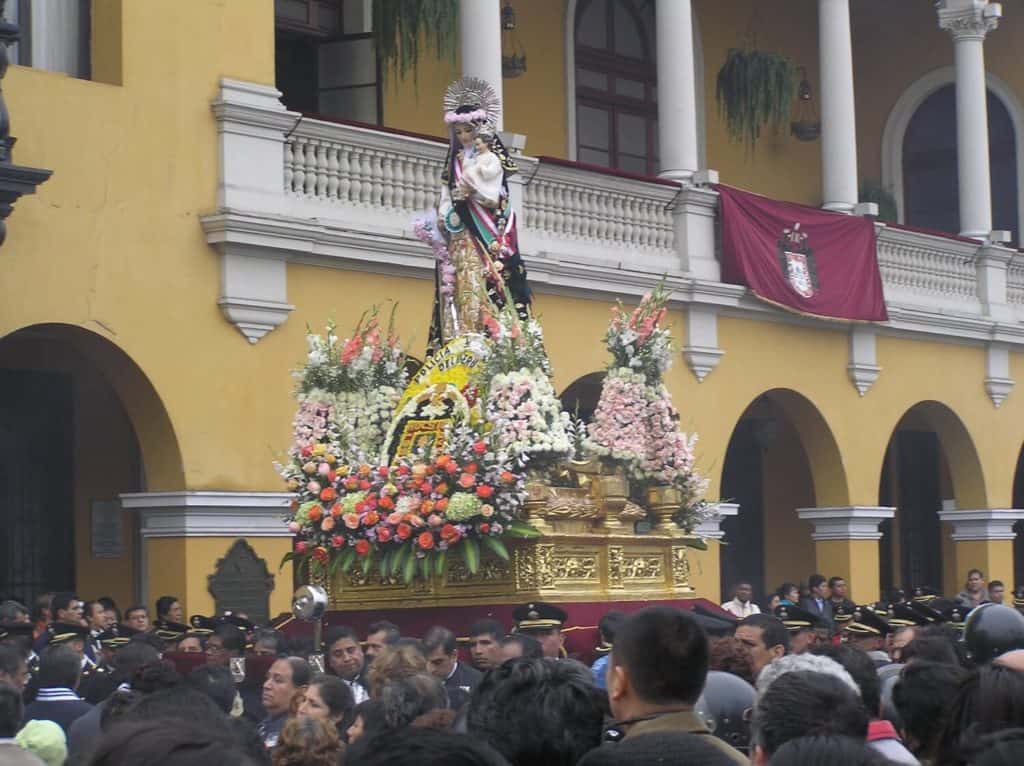
A national holiday and huge in Lima. Santa Rosa was the first saint to be beatified in the Americas and is the patron saint of the police and armed forces. Be around the Plaza de Armas at midday for a very emotive procession. Always a place of refuge from the busy Lima streets, the sanctuary of Santa Rosa de Lima on Avenida Tacna is also a good place to go any day of the year for some quiet reflection. Write a letter to Santa Rosa de Lima with your wishes, and drop it in a wishing well with a prayer for her to grant your wish.
The Virgen de Natividad is celebrated in many small rural towns and villages. In the Cusco region, the festival of the Virgin of the Nativity is particularly big in Chinchero, where it is that community’s most important festival. Mass is held for the Virgin, whose image is carried by a procession of colorfully dressed musicians and dancers. In the evening, attendees celebrate with music, dancing and fireworks.
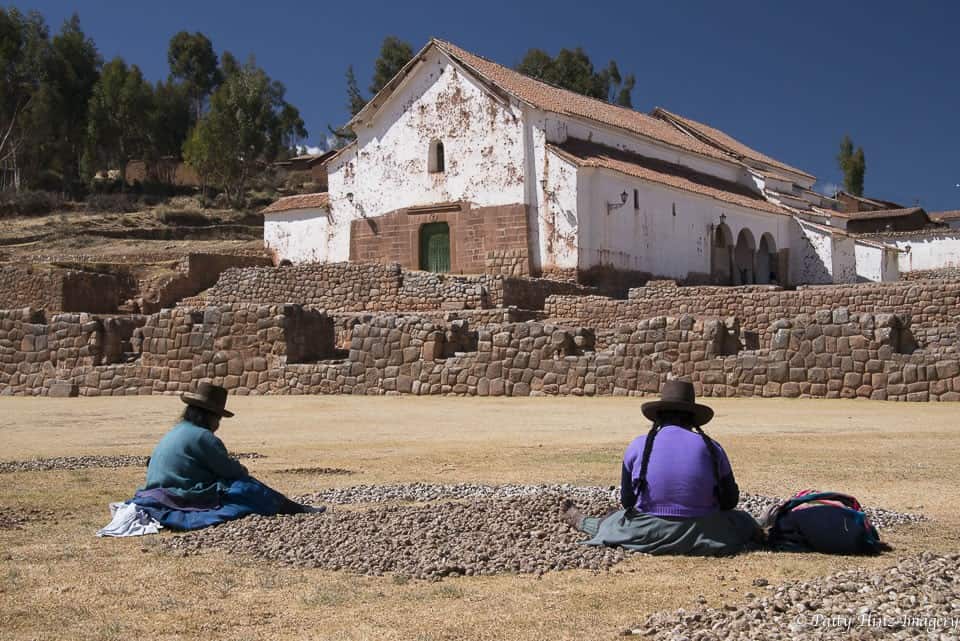
The Corpus of Almudena is a religious ceremony that dates back to the 17th Century. During the celebration, the Virgin of Almudena is honored at her own church, la Iglesia de Almudena, which includes a procession, typical dances, music and food from Cusco and the surrounding highlands.
Smaller than the main event held the week before Corpus Christi, in September the faithful return to the Sanctuary for just 1-2 days. Large festivals also take place in Ocongate and Ccatcca en route to Qoylloriti. See more details about this Peru cultural event under the June heading.
An overnight pilgrimage from Cusco to the Sanctuary of the Lord of Huanca, and a very interesting opportunity to see a combination of Catholicism and Andean religion. This sort of syncretism is a real hallmark of Peru cultural events.
Every year, on September 14, thousands of devotees from Peru, and even from as far away as Bolivia, Paraguay, Argentina and Chile, walk to the Sanctuary of the Lord of Huanca to receive the blessing of the Lord and ask that their wishes be granted; often people will take new cars to be blessed. Many believers have received the image of Christ at this Sanctuary.
As legend has it, in 1675, Diego Quispe escaped from the Yasos mine where he had suffered abuse. He hid from his master in a cave, and it is said that this place was illuminated by the presence of God. As soon as the priests of Our Lady of Mercy heard the story, they had an artist from the Cusqueñan School sent there to paint an image of the Lord in the place where it had been seen.
The pilgrimage takes three hours to walk from Huaccoto, or you can take a bus from the Coliseo Cerrado, which takes about 1.5 hours.
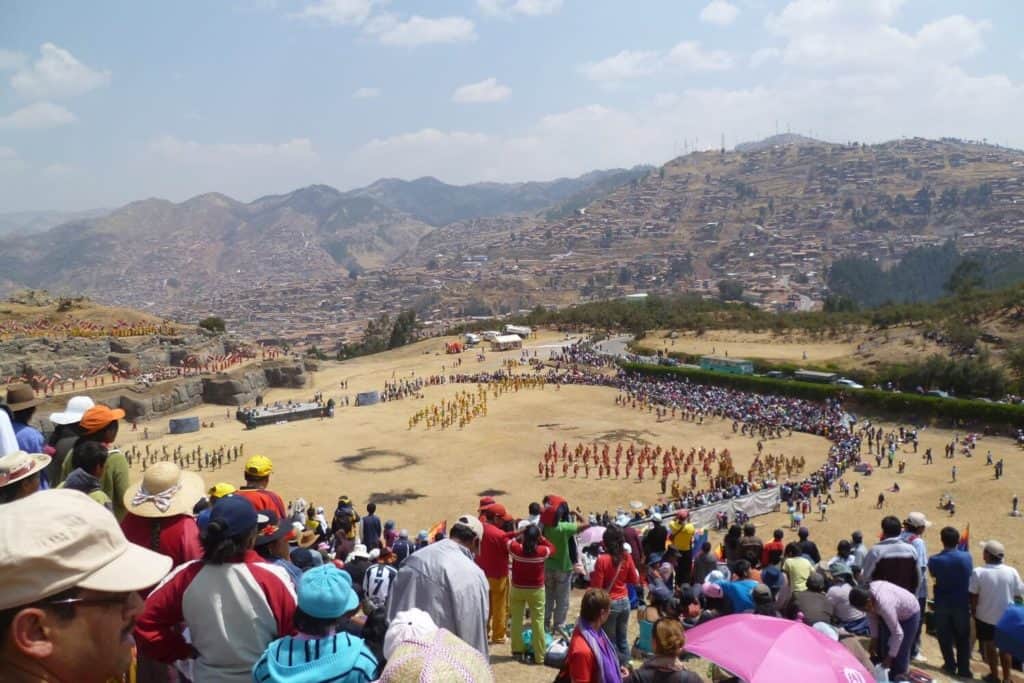
Warachikuy is a Peru festival dating back to Inca times, and was traditionally intended as an initiation ceremony for young sons of the Inca during which they earned their first wara (breechcloth). In order to earn their wara, the young men had to pass different athletic tests and sham battles. After successfully passing all their tests, participants were allowed to gain citizenship, marry and go to battle. It could be interpreted as a young Olympics, for the young men to show their physical strength to one another. Today, Warachikuy is celebrated by young men attending the Ciencias high school located in Plaza San Francisco.
These days, re-enactments of the exercises can be observed, along with traditional dances and celebrations. In many ways, this event is similar to the much more famous Inti Raymi, held in June. This event is a little less oriented towards the tourist, so is a little less polished, but includes a lot of similar dances and photographic opportunities.
>> Want to go? Be sure to contact the Tourism office ahead of time to make sure that this event will be running!
The festivity of San Jeronimo is celebrated around this Saint’s parish church in the vicinity of Cusco with dances and processions.
In the districts of Urcos in Quispicanchis province, as well as Combapata and Checacupe in Canchis province, homage is paid to the patron saint of the town with processions, fairs, bullfights and hearty pachamancas, which are delicious traditional meals cooked in shallow holes in the ground over hot stones.
Each year before the 13th of October, thousands of pilgrims arrive in the town of Ayabaca, located in the northern Peruvian department of Piura, to honor Señor Cautivo de Ayabaca. The importance of the Captive Lord of Ayabaca is based on a legend dating back to the 18th Century when three men were said to have arrived in the village and began carving a cedar trunk.
The men requested that no one see them work, and that they be given food only once a day, at dawn. After time had passed, the people of the town decided to enter the building where the men were working, but they had disappeared. In their place, they found only the statue of the Lord, and all of the uneaten food the men had been given. Because of this, the statue is said to have been made by angels.
To commemorate the date of the statue’s discovery, the Lord is carried through the town in procession on the 13th of October, accompanied by music and dancers.
This festival is one of the Peru cultural events celebrated in Ica, a city 300km south of Lima.
The origin of the devotion for the crucified Christ of Luren, the patron saint of the city of Ica, dates back to 1570, when the image was mysteriously lost in the desert during a trip from Lima to Ica, before reappearing in a desolate outpost called Luren. Later, Nicolás de Ribera the Elder, Lima’s first mayor, had a small church built in this spot as well as a hospital for highland indigenous communities.
Today, the modern church, built in a Romanticist style, houses the carved wooden image of the dying Christ, as well as those of the Virgin Mary and Mary Magdalene. On the main day of the Peru festival, the image is borne aloft in a procession through the city from nightfall until dawn the following day.
This fascinating Peru cultural event combines Catholic, Indigenous and African traditions, and is celebrated more fervently in Lima than in Cusco. It is also very popular in Santa Cruz, Bolivia.
The procession in Lima is one of the largest annual processions in all of the Americas, where tens of thousands of the faithful dress in purple tunics, sing hymns and pray as they accompany the image being carried through the streets. The origins of the Lord of the Miracles lie in colonial times, when a slave brought over from Angola drew the image of a black Christ on the walls of a wretched hut at the Pachacamilla plantation, near Lima. The image stayed on the wall despite several attempts to erase it, and even survived an earthquake intact in 1746, when all surrounding buildings were levelled.
As a result of this event, worship of the image rose to new heights, until it became the most widely venerated image in the city of Lima. The principal day of the celebration of the Lord of the Miracles is 28th October, the anniversary of the 1746 earthquake.
The litter which bears the painting weighs two tons and is borne on the shoulders of believers who set out on the traditional 24-hour procession from the church of Las Nazarenas, crossing downtown Lima until it reaches the church of La Merced in Barrios Altos. Around this time of year, the streets fill with vendors of a wide variety of typical dishes and sweets, such as the famous turrón de Doña Pepa.
Female followers of the Lord of the Miracles often wear purple for the entire month of October, and are easily identifiable by a purple dress, sashed with a white cord. There is a modest celebration in Cusco and a big procession in Santa Cruz, Bolivia.
The Día de la Canción Criolla is a national holiday celebrated most extensively on the Peruvian coast. Singers, musicians and composers pay homage to the criolla musical tradition in various celebrations and festivals
The worship of the dead was an integral part of Inca culture (the mummies of dead Incas were present at all important rituals) and part of that tradition, combined with Christian elements, still lives on today. Catholics celebrate All Saints’ Day and All Souls’ Day in the fundamental belief that there is a prayerful spiritual communion between those in the state of grace who have died and are either being purified in purgatory or are in heaven.
Todos Santos begins on November 1st with a celebration for the Day of the Living. Relatives and friends get together to enjoy the typical meal called lechon (roasted pork) with tamales. The Day of the Dead is on November 2nd and many Peruvians attend mass and then head to the cemetery, bringing flowers and food to share symbolically with the souls of the dead. Relatives hold a candlelight vigil in the cemetery on the night of the 1st until dawn on the 2nd. Breads shaped like horses (caballitos) and babies or dolls (called t’anta wawa) also play an important part in the tradition.
Every year in early November, the tiny community of Huarocondo in the Sacred Valley celebrates the “Festival del Lechon,” or festival of the suckling pig. Lechon is a roast pork delicacy that is a favourite among locals, especially for important occasions like weddings and anniversaries.
Celebrated in the community of Chillca, located in the Sacred Valley district of Ollantaytambo, Misk’a Raymi is one of the Peru cultural events that celebrate the first corn harvest. Games are played, and traditional food and drink, such as chicha de jora, mazamorra, cuy, river trout and choclo with cheese are available for purchase.
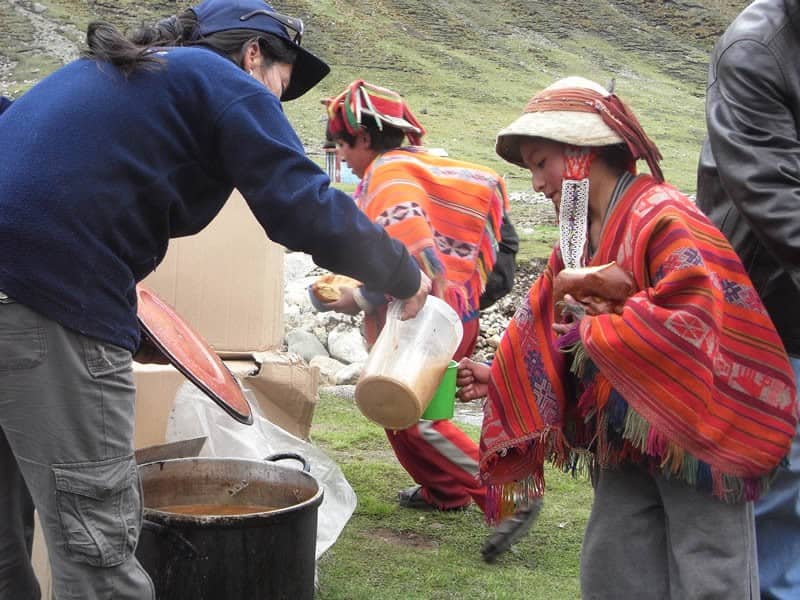
Christmas and New Year’s in Peru are really fascinating cultural experiences. One of the most interesting ways that Christmas is celebrated in Cusco is with the traditional chocolatada, where families and businesses bring hot chocolate, sweet breads and gifts to rural communities. You can join Apus Peru on a Christmas Chocolatada Trek, and take part in this wonderful cultural tradition!
Another fascinating cultural event that happens every 23rd & 24th of December in Cusco is the Santurantikuy, the “Selling of the Saints”. Cusco’s Plaza de Armas is essentially taken over by dozens of market stalls and other vendors line the streets and sidewalks selling figurines, mosses and other native grasses used for building Nativity scenes, a very popular Christmas tradition in Peru.
For more info about this special time of year, please see our Christmas in Peru and New Year’s in Peru pages!